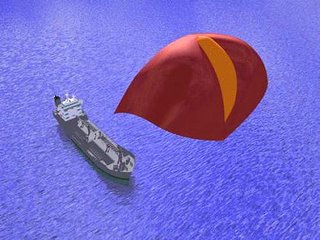Go fly a kite and haul a tanker
 I always look forward to the New York Times Annual Review in Ideas edition of their Sunday Magazine. While it contains a disproportionate share of chic and trendy stuff, there are usually more than a few really solid and potentially world-changing ideas that find their way onto the pages.
I always look forward to the New York Times Annual Review in Ideas edition of their Sunday Magazine. While it contains a disproportionate share of chic and trendy stuff, there are usually more than a few really solid and potentially world-changing ideas that find their way onto the pages.The concept of employing "free flying sails" (that look like gigantic kites) to pull ocean vessels of various sizes -- from pleasure craft to commercial tankers -- through the water is one of the more intriguing ideas that appears in this year's issue. It's so logically outrageous you hope that its developers have the right stuff to pull it off and turn it into a successful venture. That's what the folks behind KiteShip intend to do. They've taken the concept of sailing ships to a new level. Here's how they describe themselves on their Web site: "We are a group of forward-thinking sailors, designers and visionaries. We've been using the fundamental advantages of traction kites for three decades. Our goal is to bring this technology to the world."
Maybe wind energy really can cut our dependence on oil.
Sailing an Oil Tanker
By Timothy Lesle
New York Times Magazine
December 10, 2006
While you might fume about rising gas prices while filling up your car, you can always take the bus and save a few dollars. Not so if you’re in an industry tasked with, say, shipping cars or oil from one hemisphere to another. That’s one reason 2006 has been a good year for the California-based company KiteShip, which makes “very large free-flying sails”— basically, giant traction kites that harness the wind to pull very large free-floating objects.
If you’ve ever gone to the beach and seen someone kite-surfing — standing on a board while being pulled by a kite — then you’ve seen a traction kite in action. KiteShip currently sells the Outleader, which helps increase yacht speeds. And it is working to improve the range and the speed of fast ferries and oceangoing research vessels without burning more fuel. Dave Culp, the engineer who helped found KiteShip, calls the three-person operation a “micromultinational.”
But Culp has bigger plans, which helped KiteShip win the Lexus Transportation Prize at the first California Clean Tech Open this year. Culp would like to build kites of up to 50,000 square feet — roughly the size of a football field and big enough to help move cargo ships and oil tankers. Working in tandem with an engine, the kites could allow fuel savings of 15 percent to possibly 30 percent. But why kites and not traditional sails? It’s all a matter of cost, Culp says. A traditional sailing rig needs a mast, which requires either significant structural modifications — or building an entirely new ship. A kite is much more flexible and can easily be attached to an existing ship or moved from one ship to another.
KiteShip is currently talking with two of the world’s largest oil companies — macromultinationals — about testing its kites on their tankers. Who knows? In a few years, we may see tankers full of non-renewable fossil fuel being pulled across the oceans by completely renewable wind.


0 Comments:
Post a Comment
<< Home